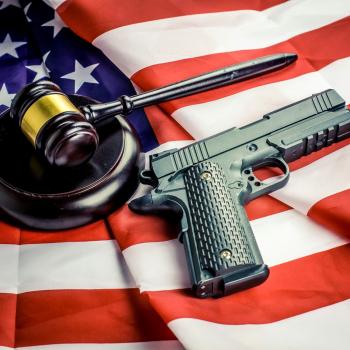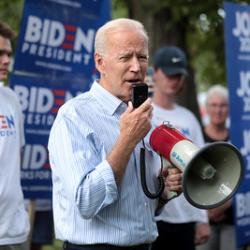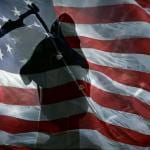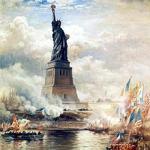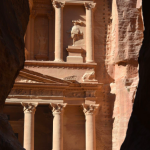Context. The zeal of some to bomb countries in the name of some general “war on terror” lacks all context, with grave implications. In other words, the use of arms is producing evils and disorders graver than the evil to be eliminated, all due to a Gnostic-Manichean dualism that has proven stubbornly immune to complexity and nuance. Indeed, there seems to be a competition in some quarters for who can espouse the most simple, dumbed-down, context-free foreign policy. For such uncomplicated strength is seen as virtuous. It’s simply us-versus-them, the good guys verus the bad guys, in this “global war on terror”. Except life is never that simple, and this has nothing to do with moral equivalence or justifying immoral acts of violence. It has everything to do with context.
Last summer, the war party in the US cheered the Israeli incursion into Lebanon, on the grounds that Hezbollah was a terrorist organization (read: bad guys) and Israel was a democratic ally (read: good guys). In retrospect, all that happened was that Hezbollah was emboldened, the Siniora government was weakened, and the region was made more unstable. Oh yes, and great numbers of civilians died. Anybody with even a basic appreciation of recent Lebanese history would have been aware of this. In the Iraq war too, the narrative is the same. The war is somehow part of the great “war on terror”, although the definition of who the enemy is seems to change by the day (Sunni nationalist? Al Qaeda? Baathist? the Mahdi army? the Iranian-linked Shia?).
There is no better way to make my point than to simply provide a narrative of the Lebanese civil war, 1975-1990. If you look at this period, you will a complicated multidimensional conflict where each side had legitimate grievances. You will see outside countries meddling and fostering instability. You will see grave evils committed by all sides. You will see that a misunderstanding of the complex historical and cultural currents can prove fatal. And you will come to the realization that peace is preferable to mutual destruction and constant war. Lebanon is an extreme example, but an apt one.
A little background. In the postwar era, Lebanon had adopted a delicate confessional structure in the political system, with fixed number of seats for each religious denomination in parliament, and a divvying-up of the top jobs. Each side felt insecure and nurtured grievances. The Christians saw Lebanon as a western country, and looked in askance at the emergence of leftist pan-Arab nationalism. The Sunnis felt that the Christians had too much influence. The Shia were the poorest group, completely marginalized, predominantly in the south. The tightly-knit Druze nurtured centuries of grievances against the Christians in the Chouf mountains. Into this powder keg stepped the PLO, as regional instability spilled into Lebanon. In 1970, the PLO was expelled from Jordan after failing to topple King Hussein and established their main base in Lebanon, with a group of fighters rivalling the Lebanese army. Lebanon was about to explode.
The first phase of the war was between the Christian Phalagists (led by Pierre Gemayel) and the Lebanese National Movement (LMN), led by Druze leader Kamal Jumblatt. The LMN was pro-PLO, and nurtured grievances about what it perceived as excessive Maronite power. Pretty soon, the LMN-PLO (joined by the main Sunni militia, al-Murabitun) were fighting the Christians. Some of the greatest atrocities of the war took place during this early phase, such as the utter destruction of the Christian town of Damour, where everybody who surrendered was massacred. At this point Syria invaded. Here’s something a lot of people forget: Hafez al-Assad originally sent in the Syrian army to protect the Christians. For sure, it was not out of altruism. Assad, ever shrewd, was fearful of a PLO victory, which would reduce Syria’s role in the region, and bring on the wrath of Israel. He also feared that Jumblatt was motivated less by the interests of Lebanon and more by a keen desire to settle the centuries-old score between the Druze and Christians. The Syrian intervention turned the tables, and the Christians won a decisive victory. Kamal Jumblatt was assassinated by the Syrians (the first in a long line), and replaced by his son, Walid, who still leads the Druze community today.
There was peace. Or so it seemed. Owing the restored stability, the Arab League gave its blessing to the Syrian occupation. The Syrian “surge” had worked! But not for long. Again, outside events influenced Lebanon. Sadat’s warming of relations with Israel scared Assad, who responded by switching his support to the PLO. Thus began phase two of the war. By this stage, the Christian militias had joined together to force the Lebanese Forces (LF), under the leadership of Bashir Gemayel, Pierre’s son. War quickly broke out between the Syrians and the LF, and Gemayel sent out feelers to Menachem Begin in Israel. He wanted Israeli threats to contain the aggressiveness of Syria, and it worked. But the war was about about to enter and new and brutal phase, possibly the worst in the long civil war.
Badgered by the PLO in Lebanon for years, Israel launched a full scale invasion in 1982. The intention was to completely destroy the PLO and its infrastructure in Lebanon. The US supported Israeli actions by vetoing a UN resolution calling for Israeli withdrawal. At this time, there was great tension in southern Lebanon between the PLO and the Shia, and the latter (through the main Shia militia, Nabi Berri’s Amal) extended a warm welcome to Israel (remember that!). Israel reached Beirut and began a 70-day siege, bombarding the city in an attempt to wipe out the PLO. Bashir Gemayel, yearning for the presidency, refused to join the Israeli offensive. Finally, Arafat withdrew from Beirut with his fighters and a multinational peacekeeping force arrived (including 800 US marines). At that time, Israel was preoccupied with extracting all remaining PLO fighters from the refugee camps. In one of the lowest points of the whole war, the LF, under the command of Elie Hobeika, and with the complicity of Ariel Sharon, broke into the Sabra and Shatilla Palestinian refugee camps and massacred civilians. Around the same time, the Syrians assassinated Bashir Gemayel, and he was replaced as president by his brother Amin.
The peacekeepers brought little peace. Although Amin Gemayel declared the war to be over, it was not. At this point, the Shia rose to greater prominence, having largely stayed on the sidelines during the war so far. Again we need to look to outside events, as the Iranian revolution had an impact on the Shia in Lebanon, who, although marginalized, were the largest single confessional group. More militant groups (including what would eventually become Hezbollah) split from Amal around this time, and one of them (Islamic Jihad) blew up the US embassy in Beirut in 1983. Syria played a shrewd game at the time. While the multinational force was propping up Gemayel’s government, the Syrians put together an alliance of Berri’s Amal (Shia), Jumblatt’s PSP (Druze), the Sunnis, and some Christians who opposed Gemayel. Fighting then broke out, in 1983, between the Christian LF and the Druze PSP in the Chouf mountains, which became more ferocious as the Israelis withdrew. Walid Jumblatt declared his intention to ethnically cleanse the Chouf mountains of Christians, and he was aided by his allies. In October 2003, Shia militants used suicide bombers to destroy both the US and French military compounds in Beirut, killing over 300 soldiers. The multinational force finally withdrew in early 1984. The new key warlords were Jumblatt and Beri, Druze and Shia. They were loyal to Syria. In September 1984, the US embassy annex in Beirut was attacked again, most likely by Hezbollah.
Following this came the “free for all” phase. The new warlords decided to end the power of the PLO once and for all, who had started to re-assert themselves upon Israeli withdrawal. Beri and Jumblatt destroyed the Sunni militia al-Murabitun, the last friend of the Palestinians in Lebanon. Syria joined in the fight against the PLO, turning yet again. Meanwhile in the south, the Shia began to make life difficult for the Israelis, despite their common cause against the Palestinians. The Christians were not quiet during this turmoil. No, they were busy fighting among themselves. As Gemayel was fatally wounded, two Christian warlords, Samir Geagea and Elie Hobieka, fought each other power. Hobeika had sought to join Syria and cement an agreement with Berri and Jumblatt (with a key role for Syria in Lebanon), but the LF revolted and Geagea took over.
It is now 1988, and Lebanon is in the midst of a constitutional crisis. Amin Gemayel’s presidential term was ending, and nobody could agree on a successor. The presidency was a Christian job, while the Sunnis controlled the prime ministership. Gemayel appointed army commander Gen. Michel Aoun as interim prime minister pending elections. The appointment of a Christian to a Sunni post was seen as provocative and Aoun’s leadership was not accepted. Pretty soon, Aoun was fighting the Syrians. He upped the ante and declared a war of liberation, and the long-suffering Lebanese suffered yet another ferocious phase in the civil war.
There was some diplomatic maneuvering behind the scenes. Under the auspices of the Arab League, a meeting of parliamentarians in Taif, Saudi Arabia, led to an agreement to end the conflict. The agreement reduced the power of Maronites to some degree, but institutionalized the confessional structure, and ensured an equal number of Christian-Muslim parliamentary seats. But the agreement also seemed to cement Syria’s role in Lebanon, giving no timetable for withdrawal, and for that reason it was rejected by Aoun. But the Taif supporters soldiered on and elected Rene Mouwad as president. But Mouwad refused to replace Aoun as army commander, and opposed any Syrian attempt to do so with force. In a replay of what happened to Bashir Gemayel, Mouwad was assassinated a couple of weeks later, and Elias Hrawi became president. Hrawi (having learned the lesson) dismissed Aoun.
However, Aoun was highly popular at this stage, and large demonstrations came to the presidential palace to support him: not only Christians, but Sunnis and Shias. In the meantime, Aoun got into a fight with Geagea when he tried to absorb the LF into the army. A government position under Taif was dangled on front of Geagea. The LF finally decided to back Taif, and full scale war broke out between Aoun’s army and the LF. Saddam Hussein had armed both sides, in yet another foreign intervention in Lebanon’s war. Syria stood back and watched its two major enemies destroy each other. Once again, global events had major implications for Lebanon, and this time Aoun was on the losing side. Seeking Syrian support in the Gulf War, the US turned against Aoun, and gave assurances that Israel would not interfere if Syria moved in to take him out. The Syrians moved in. Besieged in the presidential palace, Aoun left for exile in France. The war was finally over.
Or was it? The militias were dissolved, except for Hezbollah, with the continued Israeli occupation in the south as an excuse for them keeping their arms. Rafik Hariri became prime minister in 1992, and initiated a massive reconstruction program. Geagea was the only major player to go to jail. And Syria pulled the strings. In the 1990s, as Lebanon boomed, Hezbollah still caused mischief on the Israeli border. Israel finally left Lebanon in 2000. Hezbollah now joined common cause with its old nemesis, Yasser Arafat, now hold up in his Ramallah headquarters, and kept pressure on Israel. In 2004, Syria insisted that Lebanon amend its constitution to extend the term of office of pro-Syrian president Emile Lahoud. Syria got its wish. But prime minister Hariri resigned, and joined with Jumblatt to form a new anti-Syrian electoral coalition. They worked with the UN to bring about Resolution 1559, calling for Syrian withdrawal. In February 2005, Hariri was assassinated.
The Hariri assassination changed the Lebanese landscape, prompting the Cedar Revolution, an anti-Syrian alliance of Christians, Sunnis, and Druze that agitated, through massive demonstrations, for Syrian withdrawal. (Some in the Bush administration claimed that the Iraq war had prompted this uprising. They seemed completely oblivious to everything that had gone before). Hezbollah, alongside its Amal ally (still led by Berri), emerged as the leading pro-Syria group, and they organized counter-demonstrations accusing their opponents of being American and Israeli puppets. Syria now faced an untenable position, as the Arab world was enraged by the assassination of one of its favorite sons. It finally withdrew from Lebanon, after almost 30 years. Aoun returned from exile. The elections of May 2005 were decisive, as the Cedar alliance won 72 of the 128 seats. The opposition was made up of a peculiar alliance between Hezbollah, Amal, and Aoun’s Christians, showing once again the complex pattern of shifting allegiances in Lebanon– the architect of the war of liberation against Syria was now firmly in the pro-Syria parliamentary bloc!
Why do I tell this tale in all its gory detail? Because it offers valuable lessons, lessons about Middle Eastern politics, lessons about the futility of violence, and lessons about how history and context cannot simply be ignored. Who were the good guys and the bad guys in this war? All sides had legitimate grievances; all sides engaged in atrocities. One warlord (Geagea) went to prison, while others (Jumblatt, Barri) emerged as parliamentary leaders. Yesterday’s mortal enemy is today’s best friend.
One core lesson we can learn is that war solves little, and the search for retribution will be counterproductive. So many times, various sides thought that the next “surge” would be decisive. It never was. Sure, it may have bought a temporary respite, but not real peace; and even worse, it may have inflamed tensions even more, tensions that would end in bloodshed at some future stage. And foreign interventions are bound to backfire, as they simply were not accepted as legitimate. Sure, some groups may temporarily support a foreign power for tactical reasons, but a foreign occupier can never bring peace. Worse, the foreign interventions nearly always made matters worse. Lasting peace only comes with the withdrawal of the foreign occupation. And who are the “terrorists” here? Hezbollah? Fine, but what about those warlords sitting in parliament, as part of the American backed Cedar revolution? As noted, they also employed terrorist tactics (remember when Jumblatt tried to ethnically cleanse the Christians from the Chouf mountains). And Hezbollah, like it or not, are the elected representatives of the Shia community.
No, as Bobby Kennedy once said in a different context, “violence breeds violence, repression brings retaliation, and only a cleansing of our whole society can remove this sickness from our soul”. Peace must be secured, and peace means talking to everybody, and bringing everybody to the table with no condemnation or accusation. Easier said than done, I know, but better than the gung-go militaristic approach. Let us pray for a new approach.



